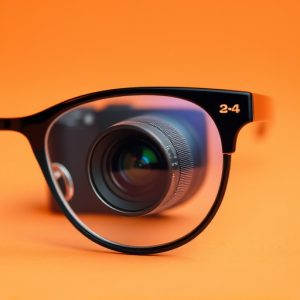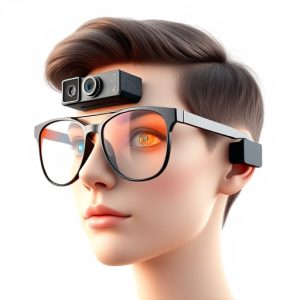Smart Glasses with Camera: Bridging Technology and Daily Use
Glasses with cameras have revolutionized wearable technology, offering a seamless blend of augmented…….
Glasses with cameras have revolutionized wearable technology, offering a seamless blend of augmented reality (AR) and hands-free functionality. These devices capture high-quality images and videos, facilitating professional tasks like real-time data overlay in fields such as surgery and manufacturing, and enabling remote assistance and immersive learning experiences. They also serve as a platform for AR, projecting digital information onto the real world, providing users with immediate contextual information. The integration of audio capabilities allows for voice-controlled interactions with various services, enhancing sensory perception through features like noise cancellation or sound amplification. These smart glasses are becoming more versatile, catering to a range of uses from professional settings to recreational activities, and are set to become even more sophisticated due to advancements in miniaturization and energy efficiency. As they evolve, these glasses promise to transform user experiences, offering a more intuitive interaction with both the physical environment and digital assistants. Despite their potential, there is an ongoing discourse on privacy and ethics, emphasizing the need for responsible use and appropriate legal frameworks to protect individual rights while leveraging the benefits of this technology.
With the advent of wearable technology, glasses with a camera built in are transforming our visual and auditory interaction with the world. This article delves into the multifaceted implications and advancements of these devices, from their seamless integration with smartphones to the myriad applications they offer in everyday life. We will explore the functionality of these high-tech spectacles, trace their evolution from concept to tangible reality, and consider the privacy and ethical challenges they present. Join us as we shed light on how these innovations are reshaping our experiences and interactions in real time.
Exploring the Functionality of Glasses with a Built-in Camera: A New Frontier in Wearable Technology
The advent of glasses equipped with cameras has ushered in a new era of wearable technology, offering users an unprecedented level of interaction with their digital surroundings. These glasses with a camera built in are not merely a novelty but a testament to the continuous innovation in the field of personal computing and augmented reality. They enable users to capture images and videos hands-free, seamlessly integrating visual documentation into everyday life. The implications for various applications are vast; from enhancing professional workflows by providing real-time data overlay in specialized fields like surgery or manufacturing, to offering a first-person perspective for remote assistance or educational purposes. The integration of cameras into eyewear also paves the way for augmented reality (AR) experiences, where digital information can be overlaid onto the real world, providing contextual information on demand and enriching the user’s environment with interactive content.
Moreover, the audio capabilities of these devices are equally transformative. The integration of microphones allows users to interact with voice-activated services, facilitating hands-free operation in a variety of settings. This dual functionality—capturing visual data and processing auditory information—makes the glasses not just a tool for content creation but also for augmenting human perception by filtering audio inputs or enhancing them through noise cancellation or sound amplification features. The potential for these devices to revolutionize how we engage with both our physical surroundings and digital assistants cannot be overstated. As they evolve, they promise to deliver a more connected and intuitive user experience, potentially reshaping the way we navigate and interact with the world around us.
The Evolution of Smart Eyewear: From Concept to Reality
The advent of smart eyewear has been a remarkable journey, marked by technological innovation and a keen understanding of consumer needs. Initially conceptualized as a fusion of fashion with functionality, glasses with a camera built in have evolved from mere prototypes to indispensable devices. Early iterations focused on the integration of cameras into frames, allowing users to capture images or record video without the need for additional gadgets. These early models laid the groundwork for what was to come, as manufacturers and designers began to explore the potential applications of such technology, ranging from augmented reality (AR) experiences to enhanced security features.
As the technology matured, the capabilities of glasses with a camera built in expanded significantly. Modern versions are equipped with advanced sensors and algorithms that enable real-time image processing, facial recognition, and even translation services. The integration of audio capabilities further enhances this evolution, providing users with hands-free access to virtual assistants, phone calls, and personalized notifications. This seamless blend of camera and audio functionalities has brought the concept of smart eyewear into the realm of practical everyday use. Today, these devices offer an array of features that cater to a wide spectrum of activities, from professional applications like remote work and teleconferencing to leisure uses such as gaming and photography. The ongoing advancements in miniaturization and power efficiency promise to make smart eyewear even more sophisticated, with the potential to transform how we interact with our digital world.
Enhanced Connectivity: How Glasses with a Camera Integrate with Smartphones and Other Devices
Glasses equipped with cameras have become a pivotal intersection of fashion and technology, offering users an augmented view of their surroundings while seamlessly integrating with smartphones and other devices. These sophisticated eyewear pieces serve as a visual and auditory extension of one’s digital life. Through Wi-Fi or Bluetooth connectivity, the glasses with a camera built in can relay real-time footage to a paired smartphone, enabling users to capture images and videos hands-free, which is particularly useful for professionals like vloggers, real estate agents, or anyone looking to document their daily experiences without interrupting their activities. The integration extends beyond mere media capture; these glasses can also receive live data, such as navigation cues or notifications, directly into the user’s field of vision, thus minimizing distractions and enhancing the interaction with one’s smart devices. Additionally, the audio capabilities allow for voice commands and hands-free operation, which can be synced with virtual assistants, further streamlining the user experience. This symbiotic relationship between glasses with a camera built in and smartphones or other devices represents a significant leap forward in personal connectivity, making everyday tasks more efficient and interconnected than ever before.
Applications and Use Cases for Everyday Life: The Versatility of In-Glass Cameras
Glasses equipped with cameras have revolutionized the way individuals interact with their surroundings, offering a myriad of practical applications for everyday life. These devices serve as a portable camera system that can capture life’s moments instantly and discretely. For instance, professionals who need to document client meetings or students taking notes in lectures find in-glass cameras invaluable tools. The ability to record without the conspicuousness of a traditional camera is a significant advantage for those desiring to maintain privacy or professionalism.
Furthermore, the integration of audio capabilities complements the visual function of these glasses, enhancing their utility in various settings. Users can engage in hands-free video conferencing, effectively bridging physical distance without the need for additional equipment. The cameras and microphones within these glasses are equally adept at capturing high-quality content for entertainment purposes, allowing users to live stream or create vlogs with ease. In social scenarios, these devices can be used to capture memorable events, such as birthday parties or family gatherings, providing a seamless blend of technology and personal experience. The versatility of glasses with a camera built in is evident in their ability to cater to diverse needs across professional, educational, and social contexts.
Privacy Considerations and Ethical Implications of Wearable Cameras in Public Spaces
Glasses equipped with cameras and audio recording capabilities have become increasingly prevalent, raising significant privacy considerations and ethical implications in public spaces. The proliferation of these wearable devices necessitates a nuanced discussion on the balance between individual rights to privacy and the societal benefits of capturing moments and sounds. Users of glasses with a camera built in must be cognizant of the potential for recording individuals without their consent, which could lead to unwanted surveillance and invasion of privacy. Legislation and social norms are evolving to address these concerns, with some jurisdictions implementing regulations that govern the use of such devices in public areas. The ethical framework governing their usage is still under debate, with arguments ranging from the protection of personal boundaries to the defense of free speech and documentation of public events. It is imperative for users to operate within legal and ethical parameters, respecting the privacy of others as they navigate public spaces. The responsibility extends to manufacturers and developers, who should design these devices with privacy safeguards and clear usage guidelines. As society adapts to the presence of glasses with camera capabilities in everyday life, it is crucial to establish a consensus on acceptable practices that protect individual privacy while preserving the freedoms and benefits these technologies can offer.


